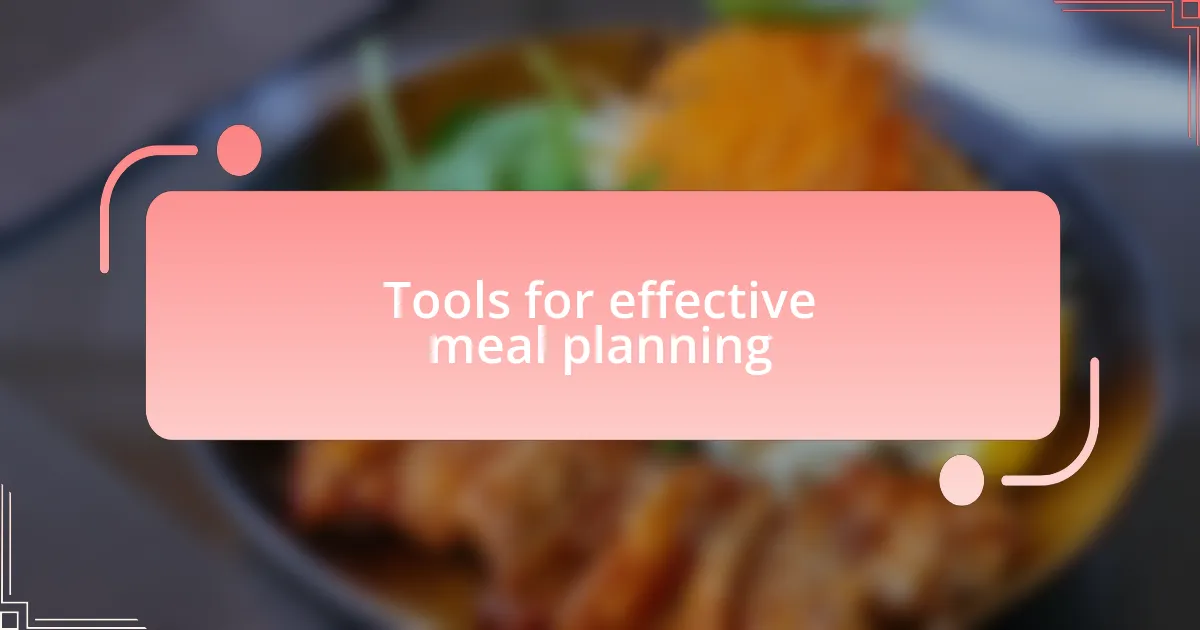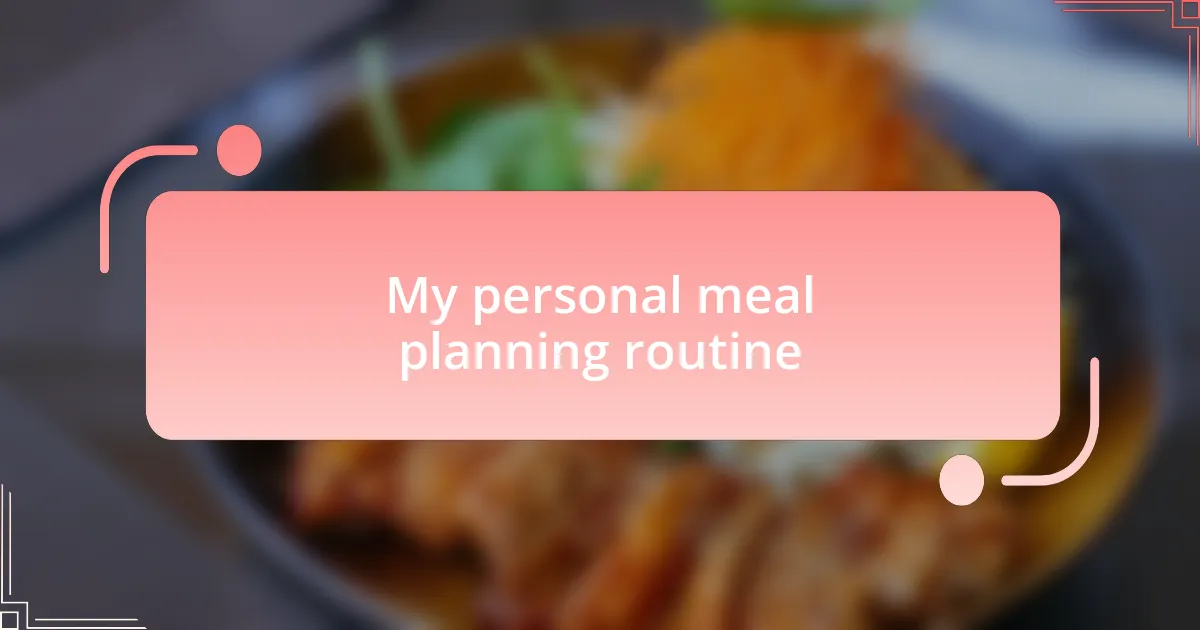Key takeaways:
- Meal planning reduces stress, encourages healthier eating, and helps save money by preventing food waste.
- Incorporating a balance of macronutrients and a variety of fruits and vegetables is essential for healthy eating.
- Using tools like meal planners, reliable storage containers, and digital recipe resources enhances the meal planning experience.
- Addressing challenges such as time constraints and family preferences can be managed through strategies like batch cooking and involving family in the planning process.

Understanding meal planning benefits
One of the most significant benefits of meal planning is the reduction in stress during busy weekdays. I remember those frantic evenings when I’d stand in front of the fridge, unsure of what to cook for dinner. By planning ahead, I’ve transformed those chaotic moments into calm, inviting cooking sessions where I can focus on creating healthy meals without the panic.
Meal planning also encourages healthier eating habits. Think about it: when I take the time to prepare my meals in advance, I’m more inclined to choose nutrient-rich foods over last-minute junk food grabs. It’s like giving myself a little gift each week, ensuring I savor meals made from fresh ingredients that nourish my body.
Additionally, meal planning can be a real money-saver. I used to impulsively buy groceries I sometimes didn’t even use, leading to waste. Now, by crafting a thoughtful grocery list based on planned meals, I’ve noticed a significant drop in my food expenses. Isn’t it rewarding to stay on budget while still enjoying delicious, home-cooked meals?

Key components of healthy eating
Healthy eating revolves around a balance of macronutrients: carbohydrates, proteins, and fats. I’ve learned that each plays a vital role in my overall well-being. For instance, when I introduced healthy fats into my diet, like avocados and nuts, I noticed not only improved energy levels but also better satiety, which made me less prone to unhealthy snacking. Have you ever thought about how each of these elements affects your daily energy?
Incorporating a variety of fruits and vegetables is another essential component of healthy eating. In my experience, the burst of colors on my plate signals not just aesthetic diversity, but also a wide range of vitamins and minerals. I’ve found that preparing meals with different vegetables from the local market each week keeps things exciting and encourages me to experiment with new flavors.
Finally, mindful eating has become a crucial aspect of my approach to health. I used to rush through meals, barely tasting my food, which I now recognize as a missed opportunity for nourishment. By taking the time to enjoy each bite, I understand my body better and can appreciate the effort that goes into preparing my meals. Have you ever noticed how slowing down can change your relationship with food?

Tools for effective meal planning
When it comes to meal planning, I’ve found that having the right tools can make a huge difference. For instance, a good planner or app helps me outline my weekly meals, ensuring I include a variety of nutrients and flavors. I remember my first attempt at meal planning; without a clear system, it felt chaotic. Now, with a simple template, I can visualize my meals and create a shopping list that aligns perfectly with my plans.
Another essential tool in my meal planning toolkit is a reliable set of kitchen containers. I can’t stress enough how much they’ve changed my meal prep experience. Having different sizes on hand allows me to portion out meals and snacks, which helps keep my diet on track throughout the week. It’s almost like a mini-reward each time I open my fridge and see neatly labeled meals waiting for me. Don’t you love the feeling of being prepared?
Lastly, I’ve come to realize the power of digital resources. Websites and social media platforms full of healthy recipes inspire me regularly. One evening, I stumbled upon a meal prep video that transformed my approach to cooking. The simplicity of the recipes made it easy to replicate, and I found myself excited to try something new every week. Have you ever felt that spark of creativity from a source outside your own kitchen? It’s those moments that push me to explore healthier options while keeping meal planning fun and engaging.

My personal meal planning routine
When it comes to my meal planning routine, I like to set aside some dedicated time each weekend to map out my meals. I usually brew a cup of tea to sip while I browse through my favorite recipe sites. It’s almost meditative; flipping through recipes gets my creative juices flowing, and I often find myself jotting down ideas that excite me. Have you ever had that moment where a recipe just calls your name? Those are the moments that drive my enthusiasm for healthy eating.
I also tend to stick with themes for the week to keep things fresh yet simple. For instance, one week might revolve around Mediterranean flavors with lots of veggies and grains, while the next dives into Asian cuisine featuring lean proteins and vibrant sauces. This strategy helps me narrow down my options and reduces the decision fatigue that often comes with planning. I’ve found that, during a particularly hectic week, having that structure saved me from many last-minute takeout decisions.
Finally, I make it a point to review how the week went. After each meal, I take a mental note of what my family and I enjoyed most. This reflection helps shape my future meal plans, ensuring I’m not only organizing but also continually improving my approach. Don’t you find that little tweaks can lead to big improvements over time? I truly believe that this iterative process is what makes meal planning a journey rather than a chore.

Overcoming meal planning challenges
One of the biggest hurdles I face in meal planning is the inevitable time crunch that sneaks up during the week. There have been days when I stare at my fridge in defeat, wondering how I can pull together something healthy in just twenty minutes. To combat this, I’ve started batch cooking on Sundays, where I prepare components like grains and roasted vegetables in advance. This way, when I’m running short on time, I can quickly assemble a nourishing meal without resorting to unhealthy convenience foods.
Sticking to a budget is another challenge I’ve had to navigate. I used to find myself splurging on fancy ingredients that seemed appealing but ultimately went unused. Now, I make a focused grocery list based on my meal plan, but I also keep an eye out for seasonal produce and sales. Have you ever noticed how fresh fruits and veggies can change from week to week? This not only keeps my meals vibrant but also helps me save money while making smart choices.
Lastly, adapting my meal planning to accommodate family preferences can feel like juggling flaming torches at times. There have been moments when I crafted what I thought was a delicious dinner, only to have my kids turn up their noses. To address this, I’ve started involving them in the planning process, letting them choose one meal each week. It’s a beautiful way to balance flexibility with structure, and it’s quite rewarding to see their excitement for meals they helped create. After all, who knew that a simple act like meal planning could also foster family bonding?